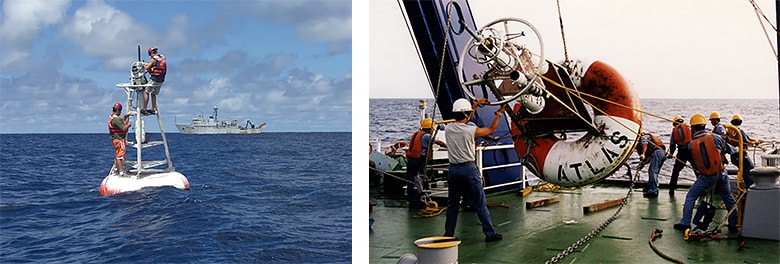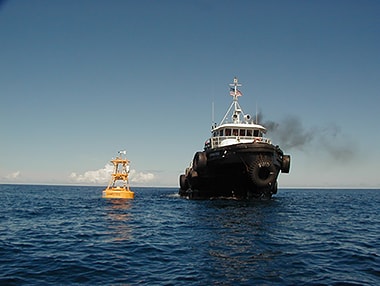- Top
- Publications
- Ocean Newsletter
- The Ocean and Our Future
Ocean Newsletter
No.387 September 20, 2016
-
The Ocean and Our Future
Conrad C. LAUTENBACHER, Jr.
Chief Executive Officer and Director, GeoOptics Inc. / Former Under Secretary of Commerce for Oceans and Atmosphere and NOAA Administrator
Selected Papers No.21The Global Earth Observing System of Systems (GEOSS) is the instrumentation infrastructure needed for earth scientists of all specialties around the world to discover and document the knowledge necessary for a sustainable human presence on earth. The Japan Agency for Marine-Earth Science and Technology (JAMSTEC) and the National Oceanic and Atmospheric Administration (NOAA) of the USA have cooperated on the Tropical Pacific Observing System, a part of GEOSS, but continuous monitoring is needed for prediction of weather change and variability around the world, and, furthermore, it is important to develop new systems, including for observation of biogeochemical variability.
Selected Papers No.21 -
The Origins of the "Tachibana"
Sayuri TERAMOTO
Ethiopia Office, Japan International Cooperation Agency (JICA)Since ancient times, the "Tachibana," or mandarin orange, has been widely appreciated as a fragrant citrus, and has also had deep ties with the ocean and imperial family. While they have grown in the wild for many years, ancient texts document the importation of the fruit, giving rise to many different theories as to its origin. After taking into account all the factors we can infer from traditional lore, the fruit's actual distribution, the presence of variant species, as well as the successes of recent research on gene mapping, we believe it likely that the Tachibana in its current form entered the Japanese archipelago through both human means and from natural propagation. -
The Psychoanalysis of Tokyo Bay
Hiroaki SUGINO
Project Researcher, The University of Tokyo Ocean AllianceOn comparing Tokyo Bay to an organism with a personality and subjecting it to psychoanalysis, I discovered complexes at its unconscious level that I would like to introduce here. If we take Tokyo Bay as a single organism and think about its development as well as its issues to be resolved, it is important to consider the complexes it is burdened with, just as a human development support professional would include a person's complexes when considering their individuality.
The Ocean and Our Future
The Ocean remains a source of wonder and amazement to humans around the globe. In addition to covering 72% of our “blue” planet’s surface, the Ocean produces our oxygen and vast quantities of food, thus serving as a major source and sustainer of life on earth. Yet, even with these impressive credentials, we remain far from truly understanding everything required to sustain a healthy Ocean and in turn create a truly sustainable planet.
Surprisingly, we know much more about the surface of the Moon and Mars than we know about the bottom of the Ocean. What we do understand is derived mostly from six satellites that circle the earth providing sea surface topography from which an approximation of the bottom topography is inferred. While detailing the physical characteristics of the Ocean are important, we are far less knowledgeable in comprehending the full range of ocean chemistry and biology that sustains life in the ocean and on earth.
Earth’s population rise over the last 50 years has been astonishing, and future projections are clearly beyond anything ever seen in the years of our planet’s existence. How can we support the extra billions of humans projected to be on the planet by 2100? How can we effectively resolve the many large-scale issues that hinder us even today such as climate change, ocean degradation, and adequate supplies of food, water, and clean energy? Increasing the global priority dedicated to understanding how our planet truly functions is a critical first step!
It should be recognized that Earth is a system of systems — systems that affect and are coupled with each other in ways that create the rhythms of life. Large scale understanding of the systems individually is necessary but not sufficient to understand the complexities of global life and processes. Instruments and studies within and across the boundaries of solid earth, ocean, and atmosphere are necessary to reveal detailed knowledge of the physical, chemical and biological connections and interconnections.
Large-scale multi-disciplinary studies have become critical for understanding the components that can support a sustainable human presence on Earth. At this level, the full involvement of governments and large organizations, both commercial and philanthropic, are required to support and maintain current observing systems as well as to move ahead with new technically advanced instrumentation.
As a Pacific sailor having spent significant time both on the Ocean and in the nations surrounding this Pacific portion of the Ocean, I much appreciate the interest and support of all who have invested in knowing more about the Ocean. I particularly respect and applaud the close cooperation and mutual partnerships that Japan and the United States have both initiated and sustained over decades of work together. Both are sea faring nations whose overall commerce and economies depend critically on the health and sustainable use of the Ocean.
Japan and the United States were founding partners of the Group on Earth Observations (GEO), a multinational organization comprised now of 100 nations and an equal number of supporting organizations collocated with the World Meteorological Organization (WMO) in Geneva. This ministerial level organization is dedicated to international coordination and cooperation in developing the Global Earth Observing System of Systems (GEOSS), the instrumentation infrastructure needed for earth scientists of all specialties around the world to discover and document the knowledge necessary for a sustainable human presence on earth.
At the business end of the GEOSS concept, Japan, employing the skills of the Japan Agency for Marine-Earth Science and Technology (JAMSTEC), and the United States, through the National Oceanic and Atmospheric Administration (NOAA), arguably have been the two most generous sponsors of the current tropical Pacific observing system which spans thousands of miles across the entire Pacific and whose centerpiece is known as the TAO/TRITON array. JAMSTEC has organized and maintained the western Pacific portion since its inception.
This system has resulted in understanding one of the basic patterns of earth’s coupled atmosphere and ocean, known in scientific circles as the El Nino Southern Oscillation (ENSO), or “El Nino”. Weather patterns around the world have now been correlated to ENSO conditions and provide advance notice of seasonal temperature and moisture patterns on all continents. Additionally, it has been established that similar and complementary patterns exist in the Indian and Atlantic Oceans, providing the world a valuable expanded window on future global weather patterns.
As with all man made instrumentation, the TAO/TRITON system is aging and requires both continued maintenance and replenishment. Fortunately, there is an international initiative in development to modernize the TAO/TRITON system with more maintainable and advanced instrumentation. The Tropical Pacific Observing System 2020 (TPOS 2020), as it is named, is an international project under the Global Ocean Observing System (GOOS) sponsored by the Intergovernmental Oceanographic Commission (IOC), a member of the United Nations Educational, Scientific and Cultural Organization (UNESCO) and a supporting organization of GEO.
Japan and the United States have a major role in the planning and development of this new system, which will include not only physical measurements, but chemical and biological instruments, a major advance in delivering key observing resources for the GEOSS. Detailed understanding of tropical biogeochemical variability and predictability would be a major step forward for informing the decisions needed for creating a sustainable planet. Once again, the United States and Japan are working together along with other Pacific nations to increase the global understanding needed by the global leaders who will be making these decisions.
I urge continued strong support from both nations. While funding for the future, such as for TPOS 2020, remains vital, continued operational funding today is also urgently needed. Planetary scale observing systems are not short term experiments but rather long term investments that must be maintained into the future. Just as we have thermometers in our homes to monitor and adjust the temperature, similar continuous monitoring of critical planetary variables is essential. For example, we cannot risk premature loss of the worldwide benefits of the current TAO/TRITON ocean observations now underpinning ocean and atmospheric weather prediction systems around the world. The long-term support of nations and large-scale commercial and philanthropic organizations is necessary to achieve the scope of knowledge of our planet and also to maintain the monitoring required for a sustainable future!

TRITON buoy (Japan)

JAMSTEC RV Kaiyo servicing NOAA TAO

